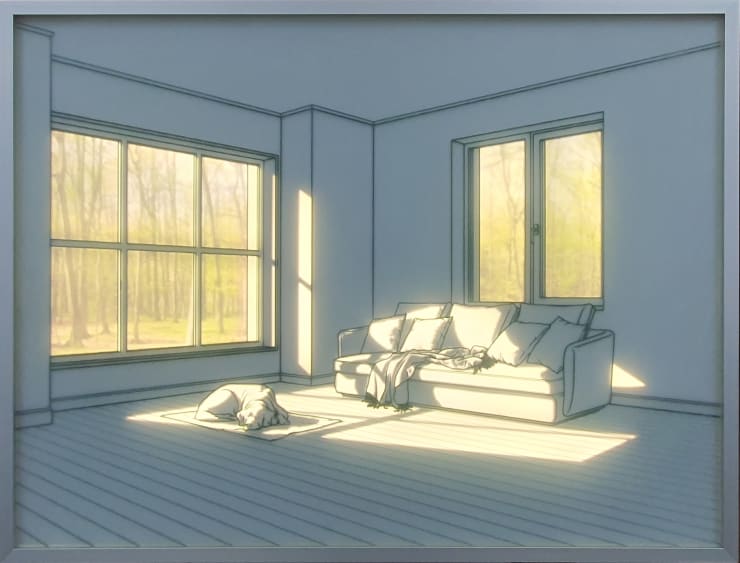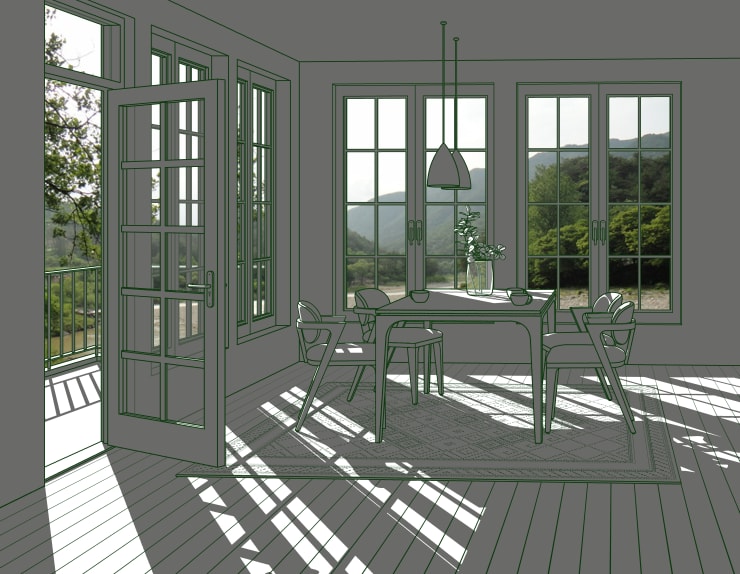Hwang Seontae: Living Light
Past exhibition
Cover
Overview
Press release
Korean artist Hwang Seontae makes lightboxes. Carefully crafted from sandblasted glass and discreet LED lamps, they depict contemporary, domestic interiors. These calm and ordered scenes are lit by windows which frame views of natural landscape. In contrast to the colour of the outdoors, these idealized, indoor spaces are monochromatic, formed from graphically-rendered line and flat, grey halftones. This is a rigidly controlled and measured vision of utopia.
Both in their content and their method of construction the pictures emphasise the articulating power of light. In the case of the images, it is ‘natural’ and therefore of the sun. Seontae’s comfortable oases can only be experienced by its action. It nurtures the man-made aspirations of the architecture. The natural world, glimpsed through the windows, powers that which happens within.
This world is unpopulated. There is a sense of absence, or perhaps, imminent presence. These homes are not neglected or in decay, they betray no evidence of abandonment or disaster, but are nevertheless, ambiguous. They are prepared for occupation, for relaxation. All is ready: chairs, tables and lamps are arranged just-so, pictures are hung, fruit and flowers set in bowls and vases. They are perfectly-staged backdrops for human activity. Where are the actors?
We are invited to concoct a story. What settings are these? Is it a dystopian dream world of inexplicable disappearance or, more prosaically, a homecoming, reunion, or familial confrontation? Drama springs out of what first appears anodyne and non-committal, a formal exercise in symmetry and harmonic arrangement. We can interpret these works as saying that sometimes, contrary to appearances, this is a far from frictionless existence. Our costly refuges, beautiful and soothing as they may be, are fragile holding-pens for all the messy turmoil of our lives. In Seontae’s work this idea is illuminated and redeemed by the life force of the sun.
Works
-
 Hwang Seontae, The Space with Sunshine XIII, 2023
Hwang Seontae, The Space with Sunshine XIII, 2023 -
 Hwang Seontae, The Space with Sunshine XII, 2022
Hwang Seontae, The Space with Sunshine XII, 2022 -
 Hwang Seontae, The Space with Sunshine XI, 2022
Hwang Seontae, The Space with Sunshine XI, 2022 -
 Hwang Seontae, The Space with Sunshine X, 2022
Hwang Seontae, The Space with Sunshine X, 2022 -
 Hwang Seontae, The Space with Sunshine VIII, 2023
Hwang Seontae, The Space with Sunshine VIII, 2023 -
 Hwang Seontae, The Space with Sunshine VII, 2023
Hwang Seontae, The Space with Sunshine VII, 2023 -
 Hwang Seontae, The Space with Sunshine VI, 2023
Hwang Seontae, The Space with Sunshine VI, 2023 -
 Hwang Seontae, The Space with Sunshine V, 2022
Hwang Seontae, The Space with Sunshine V, 2022 -
 Hwang SeontaeThe Space with Sunshine III, 2022Tempered Glass, Sandblast & LED Backlit44 x 60 x 1 ½ in
Hwang SeontaeThe Space with Sunshine III, 2022Tempered Glass, Sandblast & LED Backlit44 x 60 x 1 ½ in
112 x 152 x 4 cm -
 Hwang SeontaeThe Space with Sunshine I, 2022Tempered Glass, Sandblast & LED Backlit34 ½ x 79 ½ x 1 ½ in
Hwang SeontaeThe Space with Sunshine I, 2022Tempered Glass, Sandblast & LED Backlit34 ½ x 79 ½ x 1 ½ in
87 x 202 x 4 cm -
 Hwang SeontaeThe Space with Sunshine II, 2022Tempered Glass, Sandblast & LED Backlit34 ½ x 79 ½ x 1 ½ in
Hwang SeontaeThe Space with Sunshine II, 2022Tempered Glass, Sandblast & LED Backlit34 ½ x 79 ½ x 1 ½ in
87 x 202 x 4 cm -
 Hwang Seontae, The Space with Sunshine IV, 2022
Hwang Seontae, The Space with Sunshine IV, 2022 -
 Hwang Seontae, The Space with Sunshine IX, 2023
Hwang Seontae, The Space with Sunshine IX, 2023 -
 Hwang SeontaeThe Sunshine Room, 2016Tempered glass, sandblast, and LED24 ½ x 86 ½ x 1 ½ in
Hwang SeontaeThe Sunshine Room, 2016Tempered glass, sandblast, and LED24 ½ x 86 ½ x 1 ½ in
62 x 220 x 4 cm















